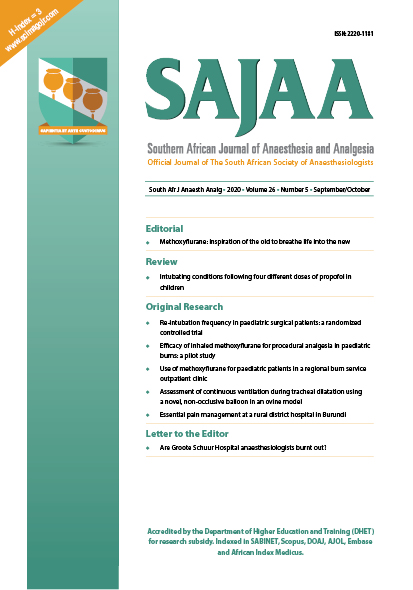Intubating conditions following four different doses of propofol in children
Keywords:
day case surgery, propofol, intubation, paediatrics, anaesthesiaAbstract
Background: Day case surgery offers advantages to the patient, the family and the performing institution. Children are excellent candidates since they are generally healthy and often require brief surgical interventions. Day case surgery requires rapid emergence from anaesthesia, minimal delay in recovery and rapid readiness for discharge from the ward. The ideal anaesthetic agents should have rapid onset, short duration, minimal side effects and minimal residual effects. The pharmacodynamics and -kinetics of propofol and alfentanil are well suited for day case surgery and may obviate the need for muscle relaxants. The purpose of our study was to determine the optimal dosing schedules for intubation following propofol combined with alfentanil and sevoflurane anaesthesia while maintaining haemodynamic stability as these dosing schedules still warrant refinement.
Methods: We conducted a randomised prospective blinded study in which fifty-nine children (aged 3–10 years) presenting for dental extractions were induced with sevoflurane (in 50% oxygen/nitrous oxide), then received propofol (0.5, 1, 1.5 or 2 mg/kg) and alfentanil (10 μg/kg) to aid intubation. For each dose of propofol, the ease of intubation (assessed by the Helbo-Hansen score) was correlated with blood pressure and pulse rate (prior, during and after intubation) to determine the optimal propofol dosage allowing adequate intubation conditions with the least haemodynamic effects.
Results: Overall adequacy of intubating conditions improved significantly (p = 0.0079) as propofol dose increased. Similarly, decrease in vocal cord movement (p = 0.0341), incidence of coughing (p = 0.0379) and limb movement (p = 0.0165) was observed. Ease of laryngoscopy and jaw relaxation did not improve significantly (p = 0.1319 and 0.1971 respectively). Changes in systolic, diastolic and mean arterial pressure as propofol dose increased were not statistically significant.
Conclusion: Propofol in a dose of 1.5 to 2 mg/kg (when used in conjunction with alfentanil 10 μg/kg, after sevoflurane induction) allowed adequate intubating conditions whilst maintaining cardiovascular stability. The decrease in blood pressure, although not statistically significant, may become clinically relevant in children with underlying cardiovascular disease. This drug combination seems to be a reasonable means for avoiding the need for muscle relaxation for children who require tracheal intubation for brief surgical procedures.
The full article is available at https://doi.org/10.36303/SAJAA.2020.26.5.2322
Downloads
Published
Issue
Section
License
By submitting manuscripts to SAJAA, authors of original articles are assigning copyright to the SA Society of Anaesthesiologists. Authors may use their own work after publication without written permission, provided they acknowledge the original source. Individuals and academic institutions may freely copy and distribute articles published in SAJAA for educational and research purposes without obtaining permission.
The work is licensed under a Creative Commons Attribution-Non-Commercial Works 4.0 South Africa License. The SAJAA does not hold itself responsible for statements made by the authors.

